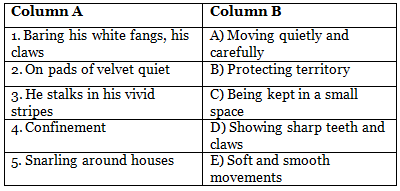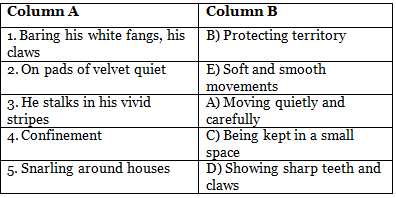Tiger Class 5 Worksheet English Gul Mohar
Q1: Multiple Choice Questions (MCQs)
(i) Where does the tiger live in the poem?
(a) In the jungle
(b) In a concrete cage at the zoo
(c) In a water hole
(d) In a village
Ans: (b)
The poem tells us that the tiger lives in a concrete cage at the zoo.
(ii) What is the mood of the tiger in the poem?
(a) Happy
(b) Angry
(c) Excited
(d) Sad
Ans: (b)
The word "rage" in the poem tells us that the tiger's mood is angry.
(iii) Why does the tiger snarl around houses at the jungle's edge?
(a) To make friends with the villagers
(b) To play with children
(c) To protect its territory and show dominance
(d) To find food
Ans: (c)
The tiger snarls to show that it is in control of its territory and to keep other animals away.
(iv) What does "velvet quiet" describe in the poem?
(a) The tiger's loud movements
(b) The tiger's colorful stripes
(c) The soft and quiet way the tiger moves
(d) The tiger's food
Ans: (c)
"Velvet quiet" describes the tiger's quiet and graceful movements.
(v) What does the repetition of the word "brilliant" in the poem emphasize?
(a) The tiger's anger
(b) The tiger's stripes
(c) The brightness of the stars in the sky
(d) The tiger's love for visitors
Ans: (c)
The repetition of "brilliant" emphasizes the beauty of the stars in the sky that the tiger can only see from its cage.
Q2: Fill in the Blanks
(i) The tiger should be lurking in __________.
Ans: shadow
(ii) The tiger moves on pads of __________ quiet.
Ans: velvet
(iii) The tiger should be __________ around houses at the jungle’s edge.
Ans: snarling
(iv) The speaker hears the last voice at __________.
Ans: night
(v) The tiger's strength is behind __________.
Ans: bars
Q3: Match the Column
Match the phrases in Column A with their corresponding meanings in Column B.

Ans:

Q4: True or False
(i) The tiger is happy in the zoo.
Ans: False
The tiger is not happy in the zoo.
(ii) The tiger should be near a water hole to find food.
Ans: True
The speaker believes that the tiger should be near a water hole to find food.
(iii) The tiger ignores the visitors in the zoo.
Ans: True
The tiger ignores the visitors who come to see him.
(iv) The tiger's quiet movements are described as 'velvet quiet.'
Ans: True
'Velvet quiet' is used to describe the tiger's soft and quiet movements.
(v) The speaker approves of the concrete cell as a home for the tiger.
Ans: False
The speaker does not approve of the concrete cell as a home for the tiger.
FAQs on Tiger Class 5 Worksheet English Gul Mohar
| 1. What is the article about? |  |
| 2. How can I prepare for the Tiger Class 5 exam? |  |
| 3. What are the subjects included in the Tiger Class 5 exam? |  |
| 4. How long is the Tiger Class 5 exam? |  |
| 5. Are there any specific tips to perform well in the Tiger Class 5 exam? |  |
|
19 videos|95 docs
|

|
Explore Courses for Class 5 exam
|

|
















